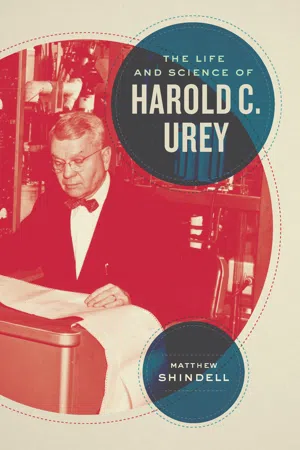
- English
- ePUB (mobile friendly)
- Available on iOS & Android
The Life and Science of Harold C. Urey
About This Book
Harold C. Urey (1893–1981), whose discoveries lie at the foundation of modern science, was one of the most famous American scientists of the twentieth century. Born in rural Indiana, his evolution from small-town farm boy to scientific celebrity made him a symbol and spokesman for American scientific authority. Because he rose to fame alongside the prestige of American science, the story of his life reflects broader changes in the social and intellectual landscape of twentieth-century America. In this, the first ever biography of the chemist, Matthew Shindell shines new light on Urey's struggles and achievements in a thoughtful exploration of the science, politics, and society of the Cold War era.From Urey's orthodox religious upbringing to his death in 1981, Shindell follows the scientist through nearly a century of American history: his discovery of deuterium and heavy water earned him the Nobel Prize in 1934, his work on the Manhattan Project helped usher in the atomic age, he initiated a generation of American scientists into the world of quantum physics and chemistry, and he took on the origin of the Moon in NASA's lunar exploration program. Despite his success, however, Urey had difficulty navigating the nuclear age. In later years he lived in the shadow of the bomb he helped create, plagued by the uncertainties unleashed by the rise of American science and unable to reconcile the consequences of scientific progress with the morality of religion.Tracing Urey's life through two world wars and the Cold War not only conveys the complex historical relationship between science and religion in the twentieth century, but it also illustrates how these complexities spilled over into the early days of space science. More than a life story, this book immerses readers in the trials and triumphs of an extraordinary man and his extraordinary times.
Frequently asked questions
Information
Notes
Introduction
Table of contents
- Cover
- Title Page
- Copyright Page
- Contents
- introduction The Making and Remaking of an American Chemist
- one From Farm Boy to Wartime Chemist
- two From Industrial Chemistry to Copenhagen
- three From Novice in Europe to Expert in America
- four From Nobel Laureate to Manhattan Project Burnout
- five A Separation Man No More
- six A Return to Science
- seven To Hell with the Moon!
- epilogue A Life in Science
- Acknowledgments
- Notes
- List of Archives
- List of Oral History Interviews
- Bibliography
- Index